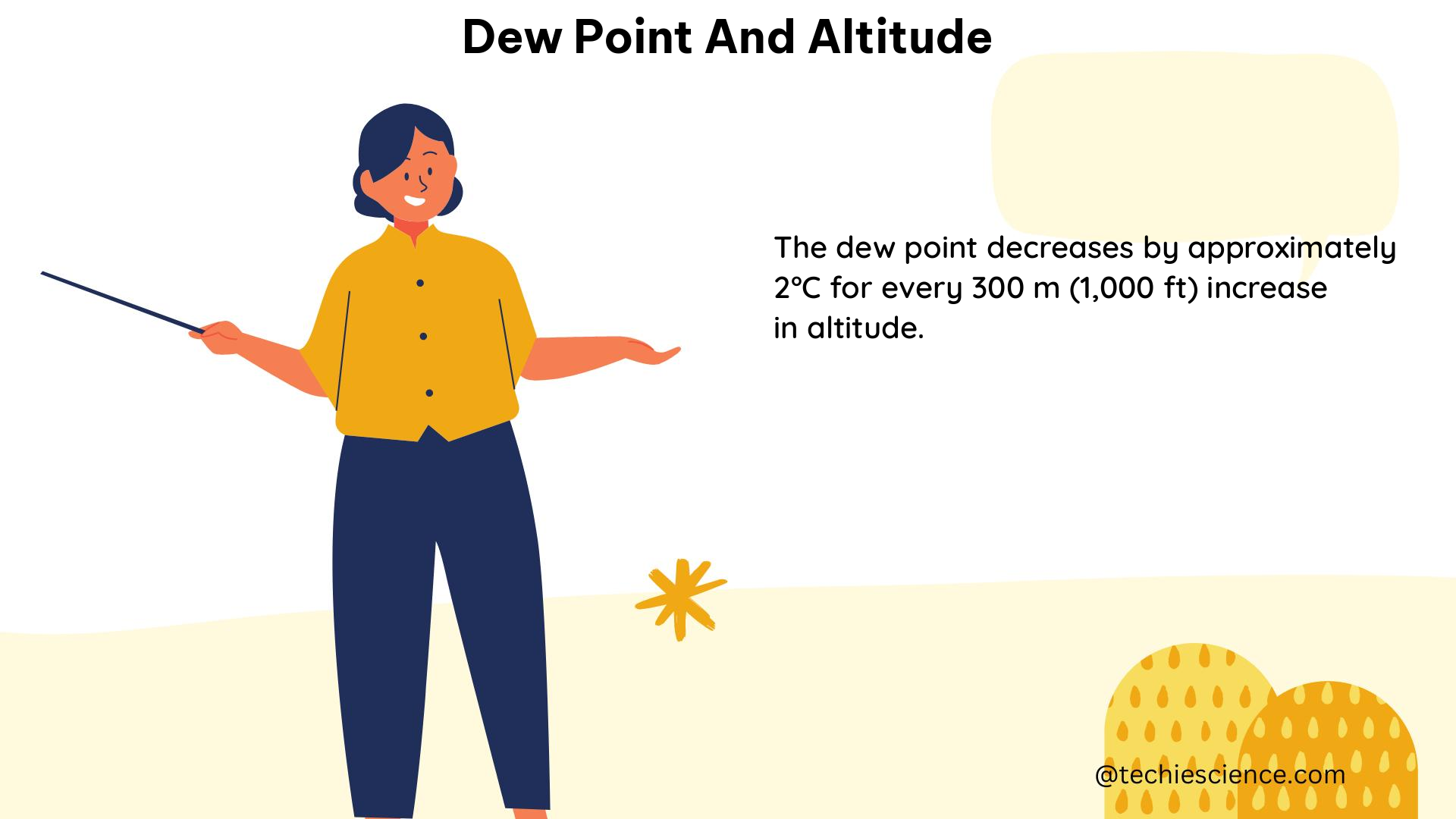Dew point and altitude are intricately linked through the concept of density altitude, which is a crucial parameter in aviation and meteorology. Density altitude is a measure of air density that takes into account temperature and pressure variations with altitude, and it can be significantly affected by the dew point, which is a measure of the amount of moisture in the air.
Understanding Density Altitude
Density altitude is the altitude at which the air density is equal to the air density at a given location, temperature, and pressure. It is calculated by taking the pressure altitude and correcting it for non-standard temperature and humidity conditions. The formula for calculating density altitude is:
Density Altitude = Pressure Altitude + [(288 – 0.00198 × Temperature in °C) / 288] × 1000
This formula shows that density altitude is primarily a function of temperature and pressure, but it can also be influenced by humidity, as represented by the dew point.
The Effect of Dew Point on Density Altitude

According to a study by Guinn and Barry (2016), density altitude is a function only of dew-point temperature for a given pressure altitude. They found that the absolute errors between density altitude calculations that incorporate humidity and those that do not are significant, and they created a simple rule of thumb for diagnosing the impact of humidity on density altitude.
The rule of thumb is that the correction (in feet) is simply twenty times the dew-point temperature in Celsius, or colloquially, “double the dew point and add a zero.” This rule of thumb is shown to limit the percent error in density-altitude calculations to within 5% for the range of dew-point temperatures between 5°C to 30°C and elevations below 6,000 feet, compared to over 20% for the same conditions using the dry case alone.
For example, if the dew point is 15°C, the correction to the density altitude would be:
Dew point correction = 20 × 15°C = 300 feet
This correction would then be added to the density altitude calculated using the standard formula.
The Effect of Altitude on Dew Point
The relationship between dew point and altitude is not a simple one, as it can be influenced by various factors, such as temperature, pressure, and humidity. In general, as altitude increases, the dew point tends to decrease due to the lower air pressure and temperature.
However, the rate of decrease in dew point with altitude can vary depending on the specific atmospheric conditions. For example, in humid environments, the dew point may not decrease as rapidly with altitude as in drier environments.
According to a study by the National Oceanic and Atmospheric Administration (NOAA), the dew point at the summit of Mount Washington (elevation 6,288 feet) was found to be consistently lower than the dew point at the base of the mountain, with an average difference of around 5°C.
Practical Applications of Dew Point and Altitude
The relationship between dew point and altitude has important practical applications, particularly in the field of aviation. Pilots need to be aware of the effects of humidity on density altitude, as it can significantly impact aircraft performance and safety.
For example, if an aircraft is taking off from a high-altitude airport with a high dew point, the density altitude may be much higher than the actual altitude, leading to reduced engine power and lift. This can make it more difficult for the aircraft to take off and climb, potentially increasing the risk of accidents.
Similarly, in the case of landing, a high density altitude due to a high dew point can make it more challenging for the aircraft to slow down and stop, as the reduced air density can affect the effectiveness of the brakes and other systems.
Numerical Examples
To illustrate the impact of dew point on density altitude, let’s consider a few numerical examples:
- Scenario 1: Pressure Altitude = 5,000 feet, Temperature = 20°C, Dew Point = 10°C
- Density Altitude (without dew point correction) = 5,000 feet
- Dew point correction = 20 × 10°C = 200 feet
-
Corrected Density Altitude = 5,000 feet + 200 feet = 5,200 feet
-
Scenario 2: Pressure Altitude = 8,000 feet, Temperature = 15°C, Dew Point = 5°C
- Density Altitude (without dew point correction) = 8,000 feet
- Dew point correction = 20 × 5°C = 100 feet
-
Corrected Density Altitude = 8,000 feet + 100 feet = 8,100 feet
-
Scenario 3: Pressure Altitude = 3,000 feet, Temperature = 25°C, Dew Point = 20°C
- Density Altitude (without dew point correction) = 3,000 feet
- Dew point correction = 20 × 20°C = 400 feet
- Corrected Density Altitude = 3,000 feet + 400 feet = 3,400 feet
These examples demonstrate how the dew point can significantly impact the density altitude, and how the simple rule of thumb can be used to quickly estimate the correction.
Conclusion
In summary, dew point and altitude are closely related through the concept of density altitude, which is a crucial parameter in aviation and meteorology. The dew point can significantly affect the density altitude, and the simple rule of thumb of “double the dew point and add a zero” can be used to quickly estimate the correction. Understanding the relationship between dew point and altitude is essential for pilots, meteorologists, and anyone working in fields where air density and its effects are important.
References
- Guinn, T. A., & Barry, R. J. (2016). Quantifying the Effects of Humidity on Density Altitude Calculations for Professional Aviation Education. International Journal of Aviation, Aeronautics, and Aerospace, 3(3), 1-10. doi:10.15394/ijaaa.2016.1124
- Vaisala. (2019). What is dew point and how to measure it? Retrieved from https://www.vaisala.com/en/blog/2019-09/what-dew-point-and-how-measure-it
- NOAA. (2007). Dewpoint and Humidity Measurements and Trends at the Summit of Mount Washington. Retrieved from https://journals.ametsoc.org/view/journals/clim/20/22/2007jcli1604.1.xml
- Aviation Stack Exchange. (2017). Does the dew point affect density altitude? Retrieved from https://aviation.stackexchange.com/questions/45095/does-the-dew-point-affect-density-altitude
- Embry-Riddle Aeronautical University. (2016). Quantifying the Effects of Humidity on Density Altitude Calculations. Retrieved from https://commons.erau.edu/ijaaa/vol3/iss3/2/

Hello, I’m Manish Naik completed my MSc Physics with Solid-State Electronics as a specialization. I have three years of experience in Article Writing on Physics subject. Writing, which aimed to provide accurate information to all readers, from beginners and experts.
In my leisure time, I love to spend my time in nature or visiting historical places.
Looking forward to connecting you through LinkedIn –